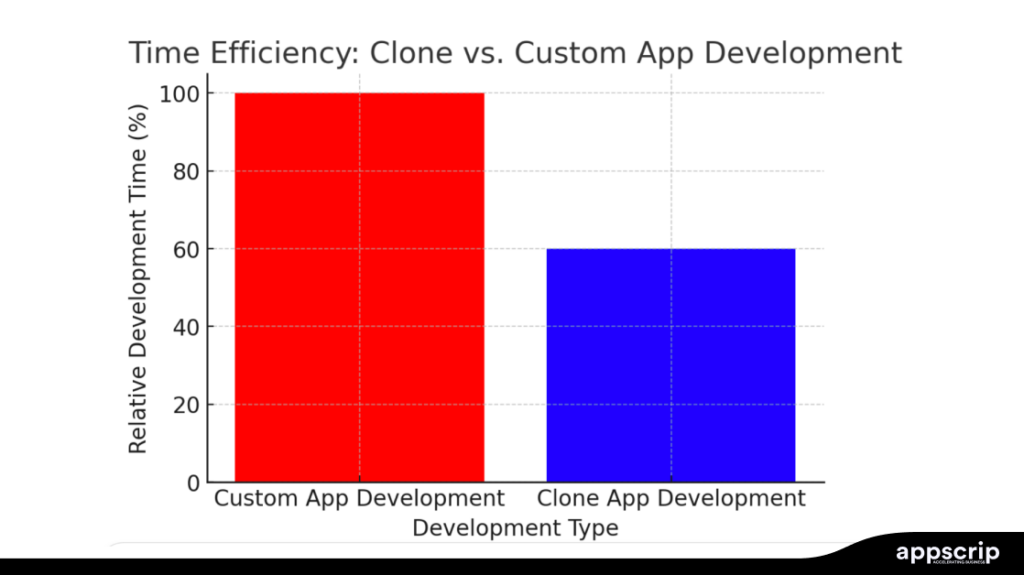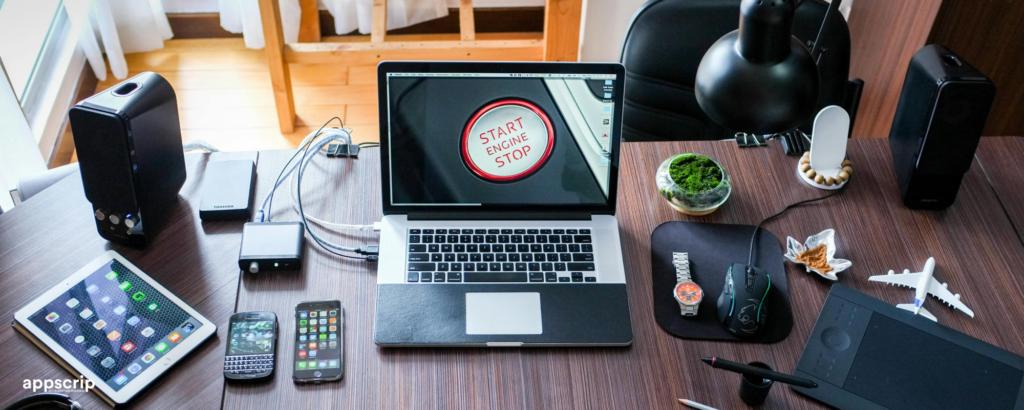An app helps businesses increase accessibility, enhance customer engagement, improve brand recognition, personalize user experiences, and more. But building an app is an expensive affair and a long drawn effort. That’s why clone app development came up.
With clone app development, businesses can build efficient apps (or clone apps) inspired by successful models. Now don’t get put-off by the word ‘clone’, even though in common parlance it means duplicating something, because that’s not the case here.
When you clone an app, you can keep the features already available in the original, then personalise and brand the app to your specific requirements.
Clone app development has found acceptance in several domains including ride-hailing to food delivery, ecommerce to online marketplace, as businesses can now enter the market quickly and save on costs as well.
Are you looking for clone app solutions and need the services of an app development agency? Appscrip has been offering app development services for almost a decade now. We also provide cutting-edge clone app solutions in several domains and our software solutions are scalable, customizable, and ready for the market.
Want to know more, get in touch.
TL;DR
- Clone App Development is creating apps inspired by successful models while customizing them for specific business needs.
- Benefits of Clone Apps include: Reduced development time, cost-effective, proven business model, customizability, faster market penetration.
- Clone App Ideas are popular in: Ride-hailing, Food delivery, Social media, E-commerce, Video streaming, On-demand services domains.
- Challenges of Clone Apps: Lack of originality, Legal risks, Market saturation Dependency on the original app.
What Is Clone App Development?
Clone app business model is the process of creating a mobile or web application inspired by an existing app, by replicating its core features, functionality and design. While you can replicate the core features, you can even customize the app to the specific needs of your business.
Clone app development should not be confused with reverse engineering – they’re two different processes.
The goal of clone app development is to take advantage of the proven success of an original app. And then add your unique requirements or improvements so as to cater to the niche requirements of your target market or user base.
Examples of popular apps that are cloned include:
- Uber Clone (for ride-sharing)
- Instagram Clone (for social media)
- Tinder Clone (for dating)
- Airbnb Clone (for vacation rentals)
- Zomato/Swiggy Clone (for food delivery)
Benefits of Clone App Development
Clone apps offer several advantages for businesses, and what matters the most is the quick-to-launch capability. We take up the top benefits along with examples.
Reduced Development Time
Building a native app takes considerable time as it is built from the scratch or ground up. The process could take months if not years, so finally you may end up with a dated product on completion.
Clone app development accelerates the development process by using a pre-built framework helping businesses launch their apps in weeks or a couple of months to gain the much needed competitive edge in the market.
Examples:
o Food Delivery Clone Apps: DoorDash and Postmates inspired by the Uber Eats model, launched their services in no time.
o Instagram Clone Apps: VSCO and EyeEm replicated Instagram’s core features to foray into the photo-sharing market rapidly.
o Uber Clone Apps: Gojek and Lyft influenced by the Uber model were able to launch ride-hailing services quickly.
Cost-Effectiveness
It takes 3 to 4 months to develop a simple mobile app, 5 to 7 months for a medium-complex app like a fitness tracker, and 8 to 12+ months for a complex social media platform or a mobile banking app. While the time frame to deploy a clone app would be mere weeks – depending on the additional functionalities needed.
Over and above clone apps provide efficient solutions for startups and SMBs, enabling them to invest more resources into marketing, customer acquisition, and scalability.
Examples:
o WhatsApp Clone Apps: Telegram and Signal used a messaging app framework to reduce development costs.
o Fitness Tracker Clone Apps: MyFitnessPal and Fitbit were built economically using existing frameworks.
o Airbnb Clone Apps: Vrbo and Homestay inspired by Airbnb model cut development expenses.
Proven Business Model
Another key advantage of clone app development is you’re choosing a product that has already proven itself in the market. When you clone a popular app you’re aware of the success of that particular business model, the target audience and now you can confidently move forward instead of experimenting with your ideas.
This mitigates the risk of failure and encourages you to put in all your efforts to run your business successfully.
Clone app development also offers the advantage to learn from others’ mistakes. Later, entrants can use this information to refine their strategies.
Examples:
o Amazon Clone Apps: Flipkart and Shopify used Amazon’s model to gain market dominance.
o Netflix Clone Apps: To succeed Hulu and Disney+ adopted Netflix’s subscription-model.
o Tinder Clone Apps: Bumble and Hinge inspired by the success of Tinder’s swiping mechanism adopted it.
Customizability
Clone app development is not a straightforward duplication of the original, but it also provides the flexibility to introduce new features, branding, and enhance user experience as per requirements.
Businesses can introduce their branding, aesthetics and more to differentiate themselves in the market. Businesses can rework the design, including salient features to make the app unique and appealing.
Examples:
o UberEats Clone Apps: Zomato and Swiggy added unique features like local cuisine and real-time tracking as differentiating factors.
o TaskRabbit Clone Apps: Handy and Thumbtack took up niche markets like home repairs or event planning.
o Spotify Clone Apps: Apple Music and Pandora introduced playlists and exclusive content.
Lower Risk
Businesses are at crossroads while launching a product regarding its acceptance in the market. In clone app development, generally only the successful ones get replicated. With the proof of demand known, companies just have to work on the execution.
In fact entrepreneurs can focus on enhancing performance, work on increasing their customer base, and introduce newer modes of monetization.
Examples:
o YouTube Clone Apps: Vimeo and Dailymotion replicated YouTube’s video-sharing model but with regional content and enhanced video quality.
o Facebook Clone Apps: LinkedIn and Twitter adopted Facebook’s core features but targeted in different niches.
o Etsy Clone Apps: Redbubble and Society6 used Etsy’s model but targeted artists and designers.
Faster Market Penetration
Businesses conduct market research before launching a product to know the target market, scope of the product and more. But clone apps bypass these steps, as they’re capitalizing on an existing demand, ensuring easy and quick user adoption.
In fact clone app development is the smart strategy for businesses foraying into a highly competitive sphere where even delay in days could hamper growth.
Examples:
o TikTok Clone Apps: Instagram Reels and YouTube Shorts gained quick traction replicating TikTok.
o Slack Clone Apps: Microsoft Teams and Discord adopted Slack’s collaboration model to hit the market rapidly.
o Dropbox Clone Apps: Google Drive and OneDrive adopted Dropbox’s cloud storage model to rope in users.
Clone App Development Time & Budget
| Clone App Type | Estimated Cost | Development Timelines | Key Features |
| Simple Clone App | $10,000 to $20,000 | 1 month to 3 months | Basic design, essential features, and single-platform compatibility. |
| Moderate Complexity App | $20,000 to $50,000 | 4 months to 7 months | Enhanced features, better UI/UX, and support for multiple platforms. |
| Complex Clone App | $50,000 to $150,000+ | 8 months to 12+ months | Advanced functionality, custom integrations, scalable architecture & more. |

Challenges and Risks of Clone App Development
The downside to clone app development is the chance of facing legal issues, lack of originality, market saturation, and more.
We take up the top challenges:
Lack of Originality
The biggest drawback to mobile app clone development is being cited for lack of originality, making it an uphill task to build brand loyalty. As the product is being modeled after an existing application, it may face difficulty in standing out in the market, especially if it isn’t overtly different from the original.
This calls for sufficient redesigning, branding, innovation and customization of the product. Users should be able to differentiate their USP and not take them to be a mere copy of the original.
Legal Concerns and Trademark Disputes
· Copyright Infringement: Similarity in features, visual design, UI, or code violates Copyright Laws. The original app could’ve Copyright Protection on the code, UI, graphics, and other aspects. By copying these elements you risk facing legal action followed by huge fines and instructions to modify your app.
· Trademark Infringement: Most apps trademark their branding elements like logo, name, aesthetics, etc. Using the same or a similar sounding name or logo could give rise to trademark infringement, with the accusation of misleading users. Trademark law inhibits using similar names or logos that could mar the identity or reputation of a brand.
· Patents: Some apps patent their technologies, processes, or features. Incorporating any patented technologies without permission, could give rise to legal action for patent infringement.
· Terms of Service Violations: Terms of Service (ToS) outline do’s and don’ts for users. Violating terms by copying content, scraping data, or using owned APIs, will give rise to legal issues. Creating apps with closely resembling content or services of other apps come under the purview of policy violations.
Dependency on the Original App
· Platform Lock-in: Depending too much on another app’s API, data, or platform will keep you subject to those rules and changes. If there’s a change in API or features, you could face broken functionality and the need to rebuild those parts.
· Limited Flexibility and Innovation: You would be handicapped to innovate and build a truly unique product. Users want new experiences and if your app is offering a similar concept, you could find yourself pitted against the original app.
· App Vulnerability: If the original app ups its game or business model, your app could become archaic or dysfunctional. Legal or regulatory challenges, will impact clones as well like a new privacy law, thereby demanding mandatory changes for compliance.
· Lack of User Trust: If users are able to deduce your app as a copy, then they may not download it fearing reliability, security, and support concerns. Without proper differentiation, users may avoid a similar functioning app.
· Reputation Risks: If the original app faces public defamation, the clones could also face the same calumny with detrimental consequences.
Limited Innovation
Innovation is an obstacle that clone apps have to contend with, as they‘re built on existing frameworks. While the core concept is well-known, clone apps suffer to come up with unique or novel features that differentiates them.
Businesses will be hindered by the original app’s design and functionalities, making it difficult to come up with radical features. To overcome this, startups must put efforts to better user experiences and introduce feature enhancements regularly.
Market Saturation
Another threat to this model is market saturation. As entrepreneurs target successful apps, it could attract too many entrants to certain niches. This will lead to market saturation. Which will in turn heighten the competition in that niche, cutting down margins, and making it difficult to gain traction.
Therefore businesses must decide which app to clone taking into consideration TAM, SAM and SOM. Then they must come up with effective marketing strategies to clearly differentiate their offering and gain users.

Popular Clone App Ideas
Clone app solutions use existing frameworks to quickly build market-presence. By this process entrepreneurs cut the risk of launching a new idea and take on the existing market demand.
Here are some of the most popular clone app ideas:
Taxi Apps
Uber and Lyft are the forerunners of urban mobility, upgrading manual systems. Taxi apps enable ride-booking services, driver-rider communication, fare estimation, real-time tracking, schedule trips, SOS button, etc. On integrating AI you enable route optimization, surge pricing, and subscription plans to enhance revenue generation and user experience.
Businesses can deploy taxi clone apps to enter this lucrative niche and come up with curated features. You could also introduce modules like courier service, package delivery, food delivery, and have local partnerships.
Food Delivery Apps
The pandemic caused the rampant adoption of food delivery apps. Now platforms like DoorDash and Uber Eats have turned this niche into a profitable sector by introducing features like restaurant listings, live tracking, multiple payment options, and user reviews. With the integration of AI, features like food recommendations, scheduled deliveries, and loyalty programs have come up.
Businesses can introduce clone apps focussing on niche segments like healthy meal deliveries, home-made food, and inculcate AI to provide recommendations for an enhanced user experience.
Social Media Apps
Social media clones of platforms like Instagram, Meta, or TikTok are part of the creator economy. Features like content sharing, live streaming, and personalized feeds help create a socially engaging platform.
Businesses can add newer monetization options, enhance privacy, create clone apps with niche focus, introduce AR filters, and blockchain-based content ownership.
E-commerce Apps
Apps like Amazon and eBay are leading entities in the online shopping space. Businesses developing cloned e-commerce apps can provide elaborate product listings, payments options, two-factor authentication, and AI-driven recommendations.
Additional features that can be imbibed using AI are voice search, chatbot support, inventory management, and shipping across continents giving businesses an upper hand over the competition.
Businesses can customize these clones for niche retail segments, subscription-based commerce, or direct-to-consumer (DTC) brands.
Video Streaming Apps
Netflix, Hulu, Disney+ and YouTube are giants in the video streaming industry generating humongous revenue. Therefore it is safe to say developing a video streaming app clone can be a lucrative venture. Clone apps can offer subscription models, regional language programs, unique content, multi-device compatibility, and adaptive streaming.
To enhance engagement, businesses can further provide interactive content, in-app purchases, content recommendations, watch real-time events, and combine with social features.
On-Demand Service Apps
On-demand platforms like TaskRabbit and UrbanClap are saviours for homes or even businesses to complete menial tasks like handyman work, furniture assembly, home cleaning – quickly and at a reasonable cost.
A clone app in this domain can include features like booking management, real-time chat support, estimation of the job, smart scheduling, automated invoicing, service bundling, video consultations, and more.
Top Apps Through Clone App Development
| App | Original App | Domain | Customizations | Success Level |
| Lyft | Uber | Ride-Hailing | Driver tipping, friend referrals, and a more driver-friendly commission model | Highly successful, 2nd largest ride-hailing service in the U.S. |
| Zomato | Yelp | Food Delivery & Reviews | Added online food ordering, restaurant partnerships, and AI-driven recommendations | Expanded globally, strong presence in India & UAE |
| Shopee | Amazon | E-commerce | Gamification features, in-app live selling, free shipping promotions | Leading e-commerce platform in Southeast Asia |
| Bigo Live | Periscope | Live Streaming | Monetization via virtual gifts, AI-powered content moderation, gamified engagement | Over 400M+ downloads, a major success in Asia |
| Helo | TikTok | Social Media | Local language content, AI-driven personalized feeds, regional influencer outreach | Popular in India before TikTok ban, millions of active users |
Step-by-Step Guide: Clone App Development
Clone app development process is essentially about taking inspiration from a successful app and building a similar one with added features. Here are 6 key steps on the process.
Step 1: Research and Requirement Gathering
Before developing a clone app, research market trends, competitors, market saturation, and target audience preferences thoroughly .
- Understand the Market: Find the original app’s target market, user demand and success rate.
- Identify Key Features: List features you want to keep from the original app. And then determine additional features keeping in mind user expectations and business goals.
- Identify Gaps In The Market: Identify gaps in your competitors’ solutions. Work out an UVP for differentiation.
- Define Your USP: Introduce customizations and improvements to make your app stand out.
- Gather Requirements: Document functional / non-functional requirements, such development strategy (iOS, Android, or both), scalability, and security.
Step 2: Choose the Right Tech Stack
Select technologies to ensure scalability, security, and performance. Also consider AI-driven analytics, blockchain for security, and microservices architecture to enhance the app’s efficiency.
- Frontend Development: Flutter, React Native, Swift (iOS) and Kotlin (Android).
- Backend Development: Django, Node.js, Laravel, Magneto, or Ruby on Rails.
- Database: MySQL, PostgreSQL, MongoDB, or Firebase.
- Cloud Services: AWS, Google Cloud, or Azure for hosting and storage.
- Real-Time Features: WebSockets or Socket.IO
- Geolocation: Google Maps API or Mapbox API
- Authentication: OAuth 2.0 or Firebase Authentication
- Payment Integration: Stripe, PayPal, or Razorpay
- Search Functionality: Elasticsearch or Algolia
- APIs: For payment gateways, maps, notifications, etc.
Step 3: Customizations
Customisation is key to stand out, your clone app should enhance user experience via new features like AI recommendations, gamification elements, branding, UI improvements, additional security layers (biometric), or multilingual support.
- Core Features: Replicate essential features (user registration, search functionality, booking elements, payment options).
- Custom Features: Add unique features to differentiate your app, (advanced filters, referrals, loyalty programs, or AI-based recommendations).
- Scalability: To handle increasing user loads or feature updates.
Step 4: Design UI/UX
Prioritise smooth navigation, attractive layouts, engaging visuals, and responsive design to enhance the user experience. Implement dark mode, voice-command navigation, and accessibility features for a broader audience.
How you go about it is:
- Wireframing: Create wireframes to fathom the app’s layout and flow.
- Prototyping: Develop interactive prototypes to test user interactions.
- UI Design: Focus on aesthetics, branding, and consistency.
- UX Design: Ensure the app is user-friendly, intuitive and provides a satisfying experience.
Step 5: Development and Testing
Automated testing frameworks, load testing, and penetration testing help in identifying and resolving issues early on.
- Agile Development: Follow an agile methodology to develop the app.
- Frontend and Backend Integration: This is to ensure smooth communication between the frontend and backend.
- Testing: Perform rigorous testing, including:
- Functional Testing
- Usability Testing
- Performance Testing
- Security Testing
- Bug Fixing: Address issues identified during testing.
Step 6: Deployment and Marketing
Utilize data-driven marketing campaigns, push notifications, and in-app advertising for better user engagement and retention.
- App Store Submission: Publish on Google Play Store and Apple App Store.
- Marketing Strategy: Use digital marketing techniques like SEO, ASO, paid ads, social media campaigns, referral programs, and influencer marketing.
- User Feedback: Collect feedback from early users to improve the app.
- Updates: Update the app regularly with new features and bug fixes.
With the right strategy, a clone app can serve as a route to long-term business success. A well-executed clone app is not only a cost-effective solution but also offers the flexibility to innovate and adapt to changing market trends.
Key Considerations to Choose a Clone App Developer
Choosing the right clone app developer is key to the success of a project. When selecting a clone app developer, consider the following factors:
Technical Expertise
Proficiency in modern tech like React Native, Flutter, Node.js, Python, AWS, and more are vital.
- Look for developers with experience in building clone apps or similar projects.
- Ensure they’re proficient in the latest tech stack (e.g., React Native, Flutter, Node.js).
Portfolio and Reviews
The developer should be experienced in building clone apps for various domains. Their portfolio should state their past projects, quality of work, and expertise.
- Check their portfolio for client testimonials.
- Look for reviews on platforms like Clutch, Upwork, or Google.
Customization Capabilities
Customization beyond basic templates is imperative. They should be flexible to include additions, and branding elements to differentiate your app.
- Ensure the developer can customize the app to meet your specific requirements.
- Verify their ability to add unique features and integrate third-party APIs.
Communication and Collaboration
Check reviews, testimonials, and ratings on Clutch, Upwork, or LinkedIn. Genuine feedback is key to fathom reliability and service quality.
- Choose a developer who communicates clearly and provides regular updates.
- Ensure they are open to feedback and can collaborate effectively.
Cost and Timeline
Take quotes from a number of developers for transparency in pricing and estimated timeline for development, testing, and deployment.
- Get a detailed cost estimate and compare it with your budget.
- Discuss the project timeline and ensure it jells with your launch plans.
Post-Launch Support
- Check if the developer offers maintenance and support services post launch.
- Ensure their capabilities on bug fixes, updates, and scalability.
Security and Compliance
- Check if they follow best practices for data security and privacy.
- Ensure their understanding with regulations (e.g., GDPR, CCPA).
The above factors can help you select a skilled clone app developer to meet your business requirements and ensure a successful app launch.
Clone App Development vs Custom App Development
| Factor | Clone App Development | Custom App Development |
| Development Time | 🚀 Faster – Uses pre-built templates, reducing time to market. | 🕒 Longer – Requires custom development from scratch. |
| Cost | 💰 Lower – Affordable since it repurposes existing code. | 💸 Higher – Custom development and design increase costs. |
| Customization | ⚙️ Limited – Restricted to the existing framework of the clone. | 🎨 High – Fully customizable to match business needs. |
| Scalability | 📉 Less scalable – Might struggle to handle large user bases. | 📈 Highly scalable – Designed to support future growth. |
| Security | 🔓 Lower – Often lacks robust security measures. | 🔒 Higher – Custom security features can be implemented. |
| Performance | 🏎️ Moderate – May not be fully optimized for all devices. | 🚀 Optimal – Smooth, efficient performance tailored to the platform. |
| Uniqueness | 🤷 Generic – Looks similar to other apps in the market. | 🌟 Unique – Can have distinct branding and features. |
| Maintenance & Updates | 🔄 Difficult – Updates depend on the original clone framework. | 🔧 Easier – Can be updated independently. |
| App Store Approval | ❌ Challenging – May face rejection due to similarity with existing apps. | ✅ Easier – Follows platform guidelines from the start. |
| Long-term Viability | ⏳ Short-term – Less sustainable due to limited flexibility. | 🔥 Long-term – Built for continuous evolution and market changes. |
Conclusion: Clone App Development
Clone app development is a pragmatic approach businesses can adapt to launch their services quickly and economically. Clone app development empowers businesses to quickly enter the market, reduce development costs, and capitalize on proven success models.
While there are challenges, the right strategy and execution can lead to success. Whether you’re entering the social media niche, ride-hailing, food delivery, or e-commerce space, a well-crafted clone app can provide a strong entry strategy.
Are you looking to take on the advantages offered by clone app development? Appscrip has a decade of app development experience building apps. We offer high-quality, customizable app clone solutions to bring your ideas to fruition. Our ready-made app solutions are available in several domains, explore them here.
We also assure you there isn’t a huge upfront cost involved, want to know more?
FAQs
Are clone apps legal?
Yes, clone apps are legal so long as they don’t violate copyright, trademark, or IP rights. It’s crucial to modify and differentiate the app considerably to avoid legal issues.
How customizable are clone apps?
Clone apps are highly customizable. Businesses can modify features, aesthetics, designs, branding, and functionalities to create a unique app that satisfies their goals and requirements.
How does a clone app differ from a custom-built app?
A clone app is built using an existing or called as pre-built framework, reducing development time and costs. But a custom-built app, on the other hand, is created from scratch, offering complete originality but requiring more time and resources.
What industries benefit most from clone app development?
Customizable clone apps have become a popular strategy for businesses across various industries, as it allows them to replicate the success of existing apps while adding unique features or targeting specific niches.
Here are the industries that benefit most: transportation and ride-sharing, food delivery and ecommerce, online marketplaces and social media, healthcare and telemedicine, on-demand, eLearning, dating, and more.





